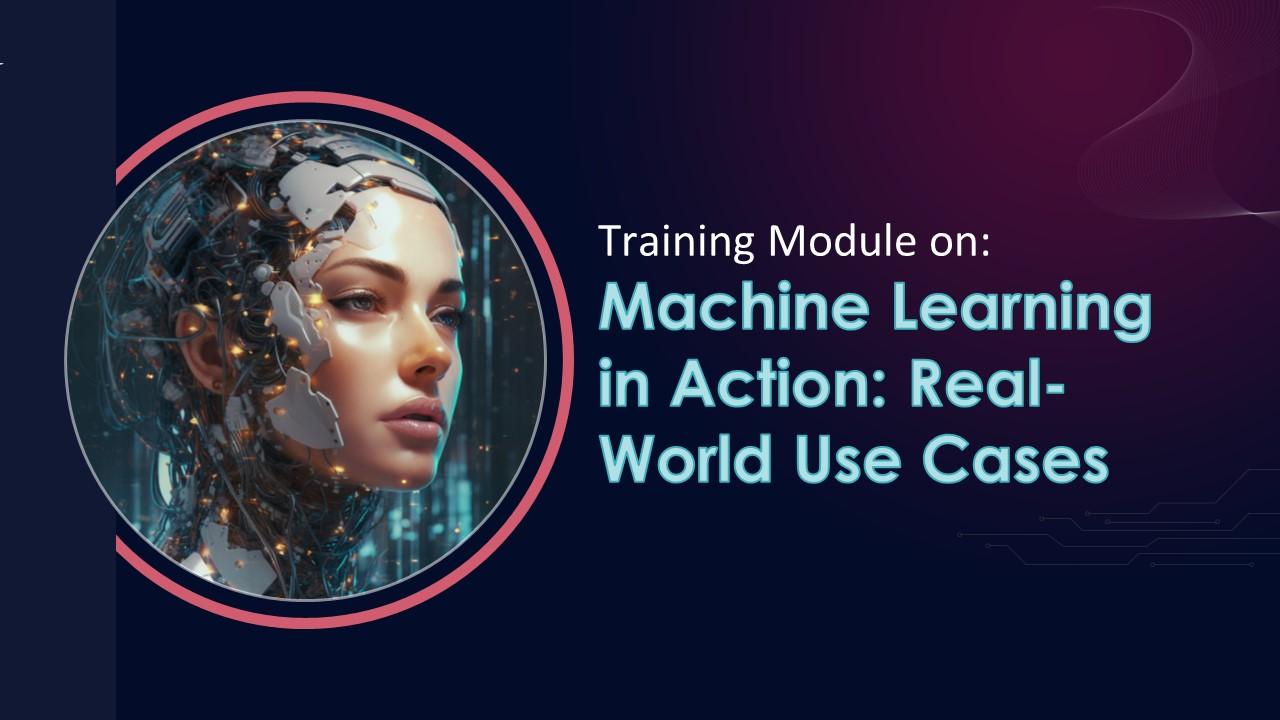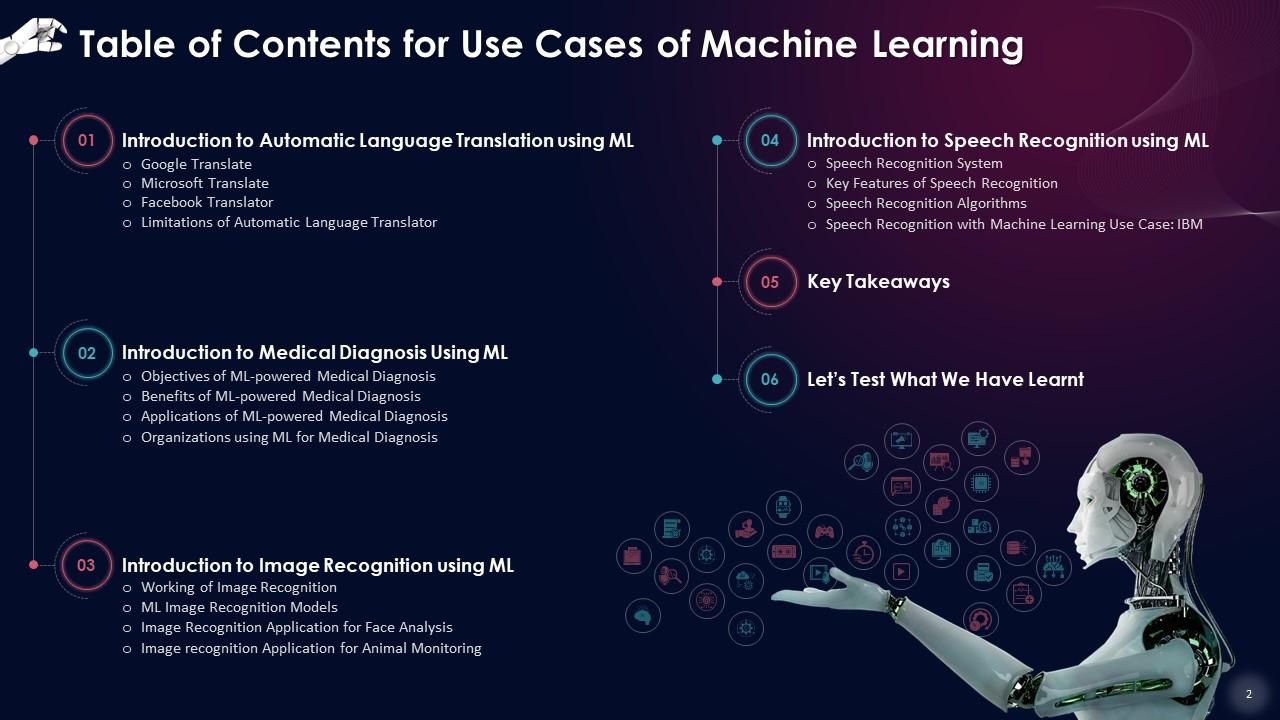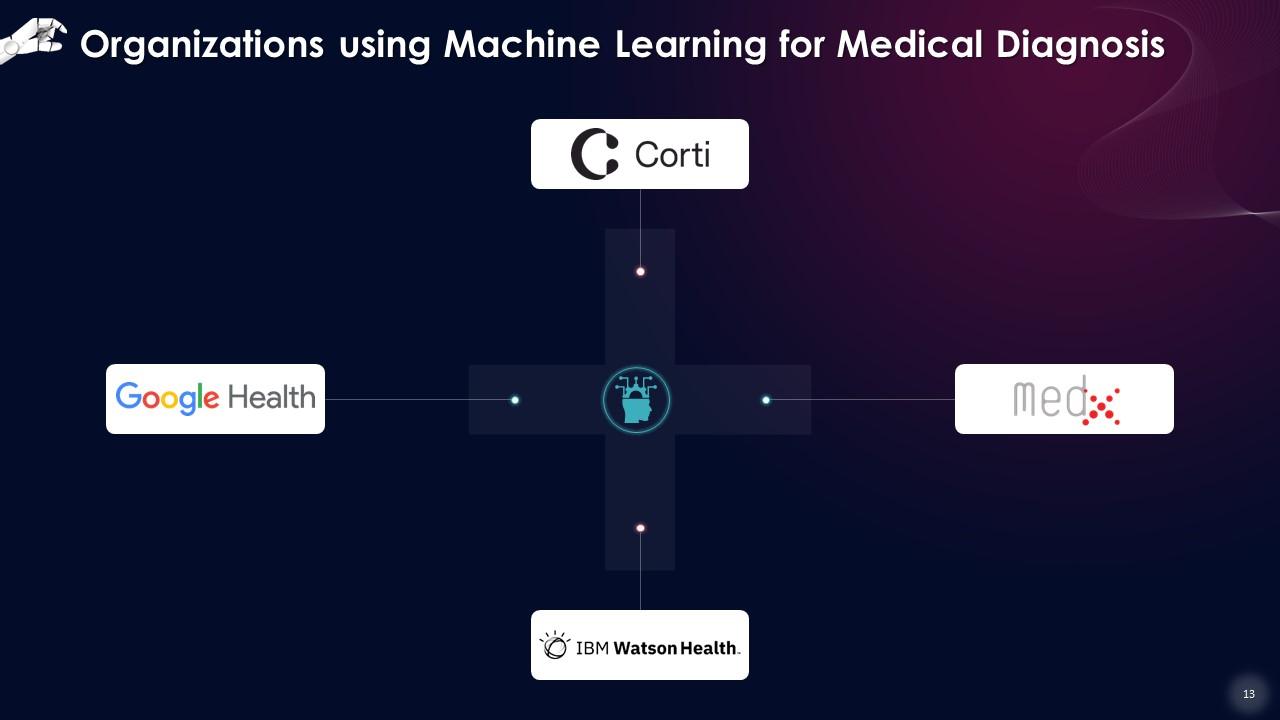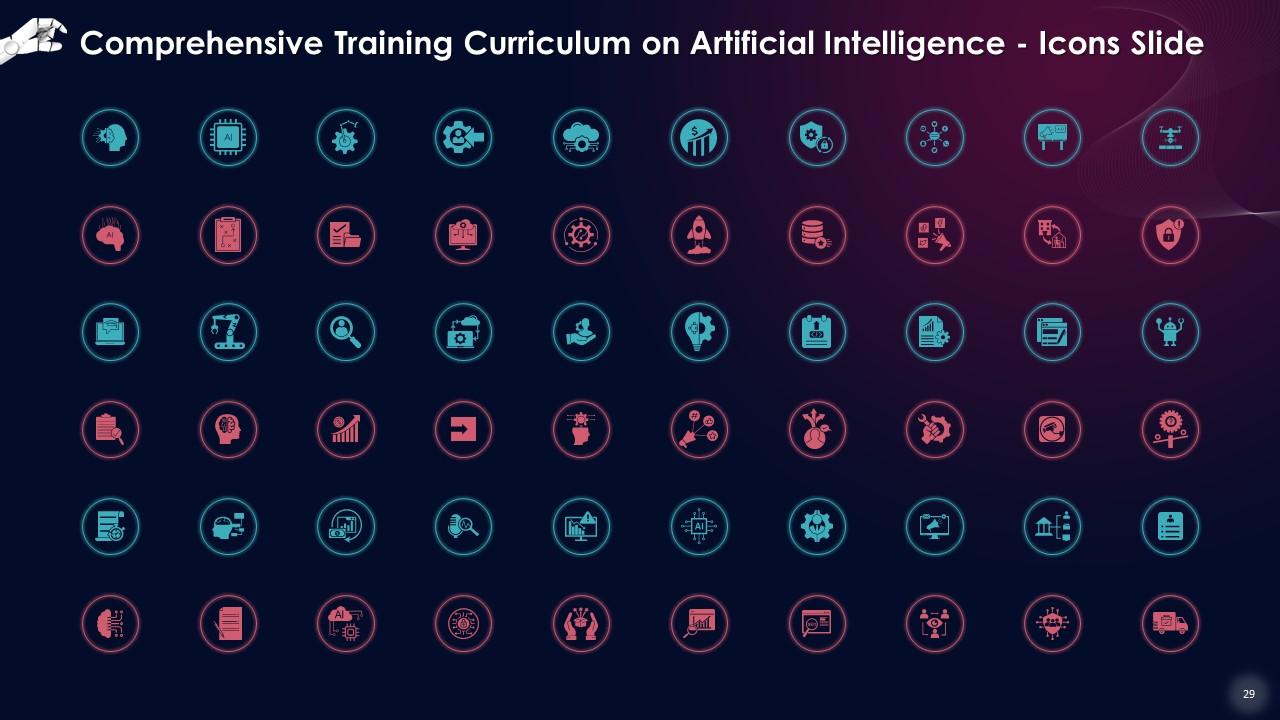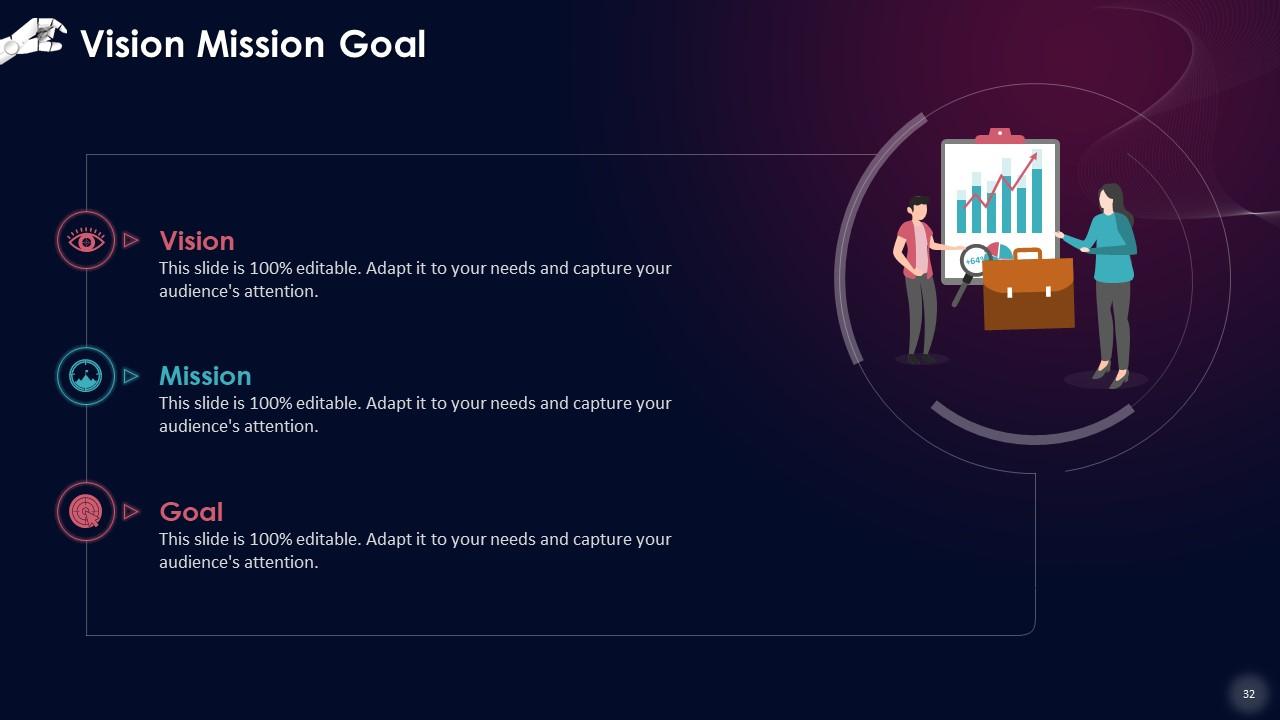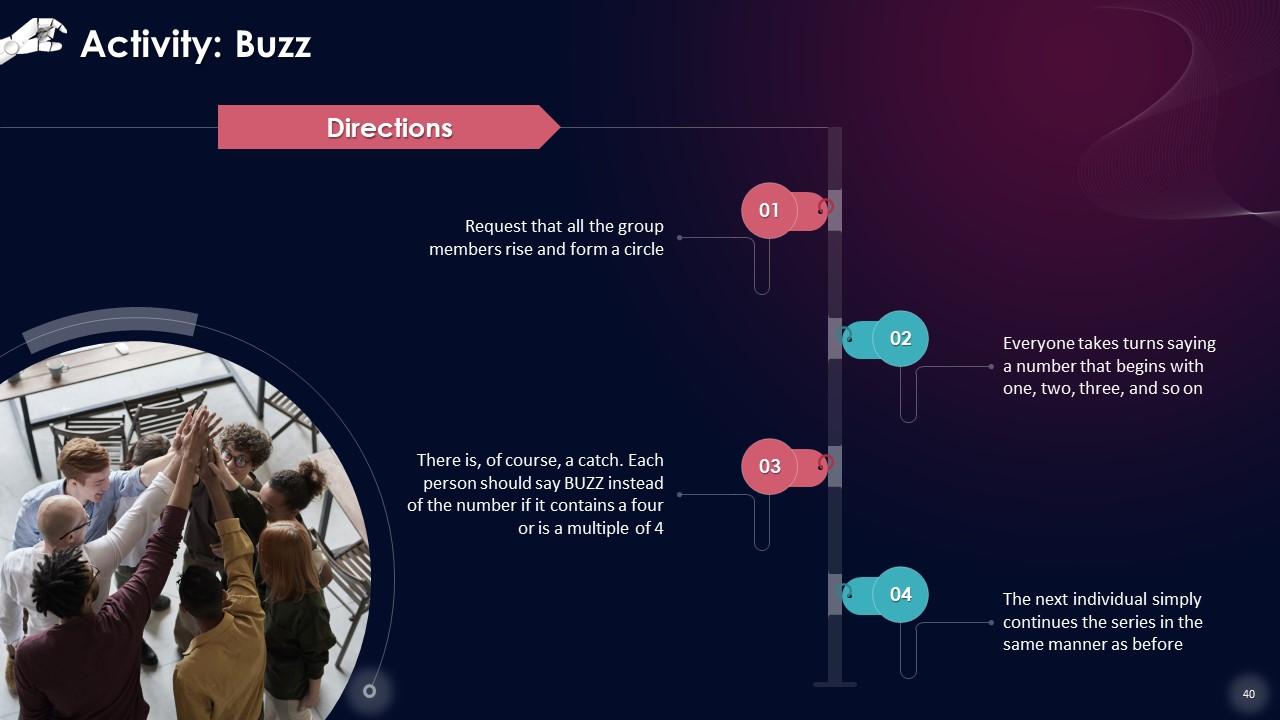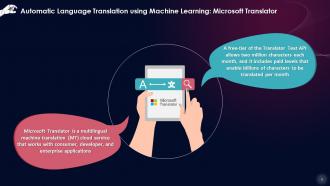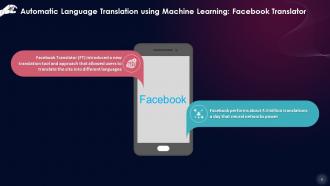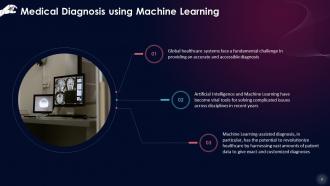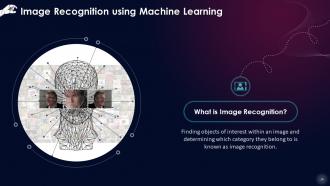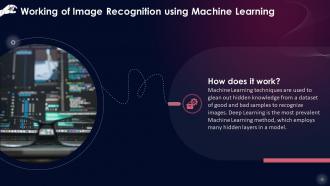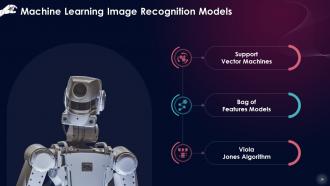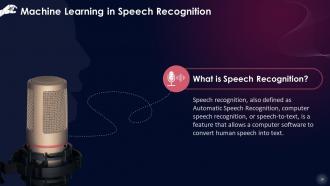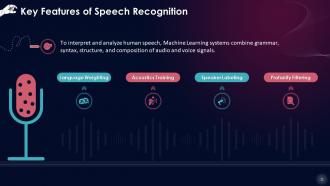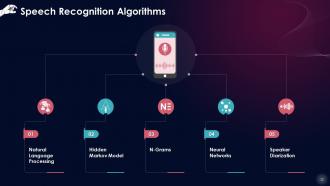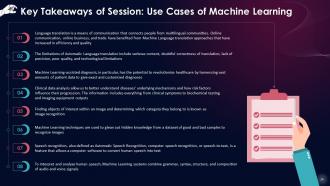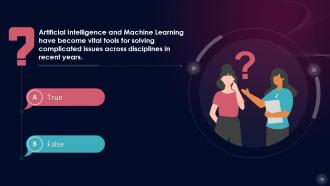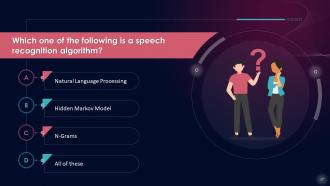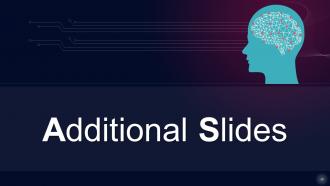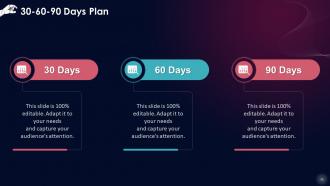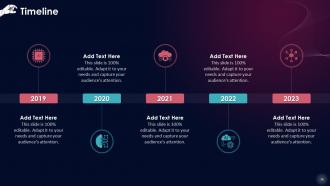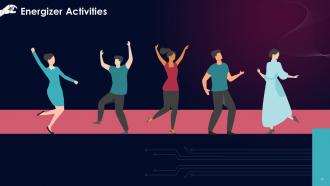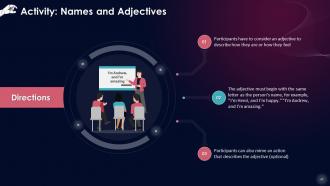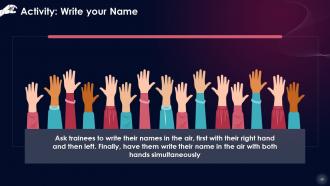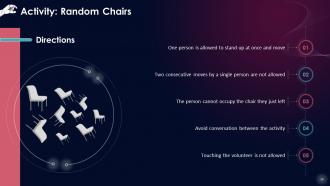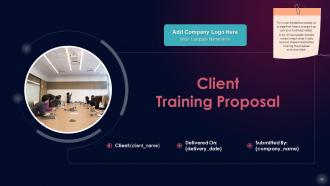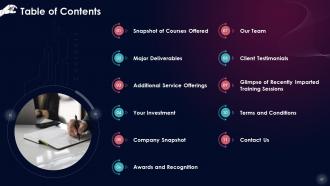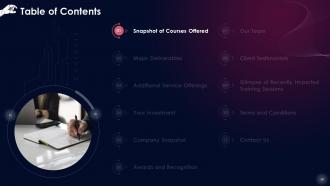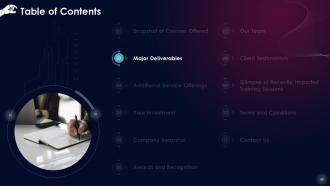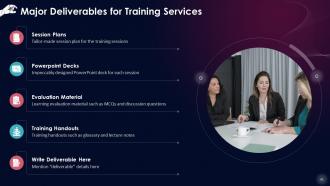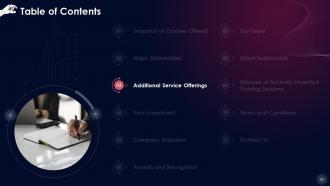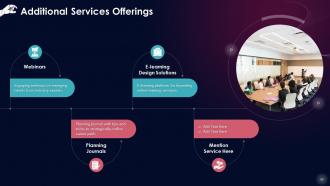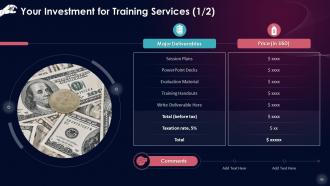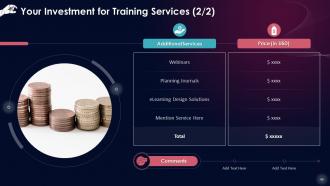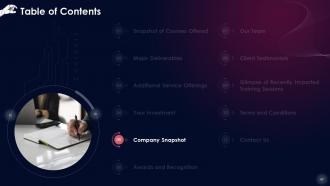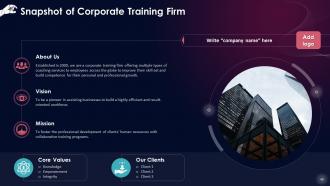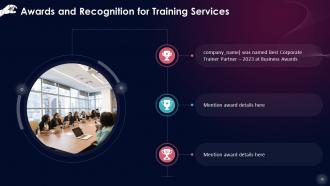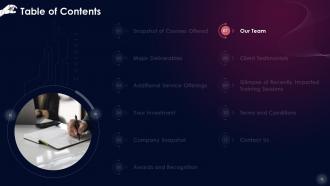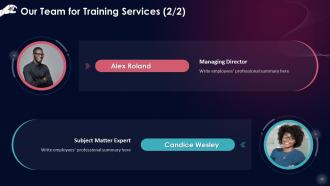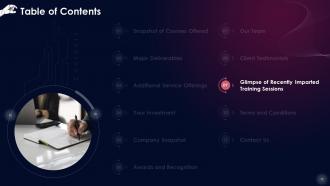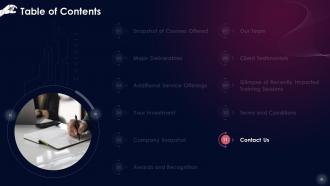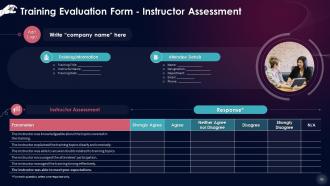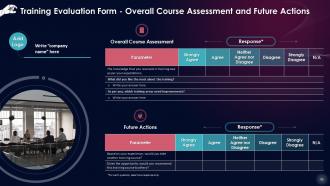Machine Learning In Action Real World Use Cases Training Ppt
This training module on Machine Learning in Action Real-World Use Cases introduces the concept of automatic language translation using machine learning by taking examples of Google Translate, Microsoft Translate, and Facebook Translator. It also provides limitations of automatic language translator. It also discusses ML-powered medical diagnosises objectives, benefits, and applications. It offers information about the working of image recognition and speech recognition using ML. It also includes Key Takeaways and Discussion Questions related to the topic to make the training session more interactive. The deck has PPT slides on About Us, Vision, Mission, Goal, 30-60-90 Days Plan, Timeline, Roadmap, Training Completion Certificate, and Energizer Activities. It also includes a Client Proposal and Assessment Form for training evaluation.
You must be logged in to download this presentation.
 Impress your
Impress your audience
Editable
of Time
PowerPoint presentation slides
Presenting Training Deck on Machine Learning in Action Real-World Use Cases. This deck comprises of 85 slides. Each slide is well crafted and designed by our PowerPoint experts. This PPT presentation is thoroughly researched by the experts, and every slide consists of appropriate content. All slides are customizable. You can add or delete the content as per your need. Not just this, you can also make the required changes in the charts and graphs. Download this professionally designed business presentation, add your content, and present it with confidence.
People who downloaded this PowerPoint presentation also viewed the following :
Content of this Powerpoint Presentation
Slide 3
This slide discusses the importance of language translation as it is a means of communication that connects people from various multilingual communities. It also emphasizes the critical importance of developing innovative technical solutions to the age-old problem of digital divide that linguistic limitations can cause.
Slide 4
This slide discusses Google Translate as a use case of Automatic Language Translation via Machine Learning. Google Translate is a multilingual translation tool that Google provides for free. It has a website interface and Android and iOS mobile apps, and developers can use its Application Programming Interface (API) to create browser extensions and software apps.
Instructor’s Notes:
Google Translate serves over 500 million individuals every day, and translates over 100 billion words per day.
Slide 5
This slide introduces Microsoft Translator as a use case of Automatic Language Translation using Machine Learning. Microsoft Translator is a multilingual machine translation (MT) cloud service that works with consumer, developer, and enterprise applications.
Slide 6
This slide talks about Facebook Translator, which is another tool used for automatic language translation. Facebook Translator (FT) introduced a new translation tool and approach that allowed users to translate the site into their languages. It supports over 100 languages.
Slide 7
This slide lists limitations of Automatic Language translation such as content loses its concise element, doubtful correctness of translation, lack of precision, poor quality, and technological limitations.
Instructor’s Notes:
- Content loses its concise element: By using an alternate word for each word in the source language, machine translation techniques dilute the information's conciseness, which makes the communication lengthy, offend the reader, and redirect their focus away from the text's primary aim
- Doubtful correctness of translation: In any language, accuracy is a must for effective communication. As a result, it's vital to remember that the integrity of the content should never be sacrificed while translating a document into another language. During the translation process, machine translation cannot maintain the text's accuracy
- Lack of precision: Computer-aided translations (CAT) cannot be at par with human translations in terms of accuracy while translating ambiguous terminology. Human translators with extensive experience can guarantee that translated materials are accurate, exact, and consistent
- Poor quality: The low quality of the translated text is a fundamental disadvantage of machine translation. Machine translations can't put the text in its appropriate context, and human translators need to be mindful of cultural references, colloquial idioms, industrial jargon, and other nuances
- Technological limitations: Many specialized solutions in this field cannot be handled since machine translation follows systematic principles. Machine translation cannot translate from file formats, such as PDF, DOC, and TXT
Slide 8
This slide illustrates the importance of Machine Learning in Medical Diagnosis. Artificial Intelligence and Machine Learning have become vital tools for solving complicated issues in disciplines in recent years. Machine Learning-assisted diagnosis, in particular, has the potential to revolutionize healthcare by harnessing vast amounts of patient data to give exact and customized diagnoses.
Slide 9
This slide depicts how Machine Learning can enhance the diagnostic model based on the information that clinical data provides. The information includes everything from clinical symptoms to biochemical testing and imaging equipment outputs.
Instructor’s Notes: Data types that can be used to achieve a precise medical diagnosis using Machine Learning are:
- Disease Data: Physiological measures and data on recognized diseases or symptoms are examples of disease data
- Environmental Data: Information concerning a person's exposure to the environment, such as smoking, sunbathing, and weather conditions
- Genetic Data: All or a significant portion of an individual's DNA sequence is referred to as genetic data
Slide 10
This slide lists the advantages of Machine Learning in Medical Diagnosis such as finding risk factors, increased diagnosis efficiency, and reducing unnecessary hospital visits.
Instructor’s Notes:
- Find Risk Factors: Find out which factors are most closely linked to the chance of contracting an illness
- Increase Diagnosis Efficiency: Diseases can be diagnosed earlier and more precisely
- Reduce Unnecessary Hospital Visits: Visits to the hospital should only be made when the patient actually requires medical attention
Slide 11
This slide highlights applications of Machine Learning in Medical Diagnosis. These applications include pathology, oncology, genetics & genomics, dermatology, and mental health.
Instructor’s Notes:
- Pathology: Given the shortage of pathologists globally, there is a solid case for using Machine Learning to advance this discipline. Pathology is also profitable for Artificial Intelligence applications due to the necessity to analyze massive datasets. Machine Learning can improve the precision of blood and culture analysis by automating tissue and cell quantification, mapping disease cells, and flagging areas of interest on a medical slide. It can also help create tumor staging paradigms and increase the speed of profile scanning to improve healthcare professionals' productivity
- Oncology: In oncology, the relevance of finding a malignant tumor early on is critical, and this is why diagnostic accuracy and precision are crucial. Oncologists can use Machine Learning to detect cancer in its early stages. Medical experts can detect somatic mutations using techniques like DeepGene (a somatic mutation is an acquired change in a genetic code of one or more cells)
- Genetics & Genomics: Machine Learning and Artificial Intelligence (AI) are essential components of preventive genetics. Scientists are using algorithms to determine how medications, chemicals, and environmental variables affect human DNA
- Dermatology: Physicians anticipate that the use of Machine Learning in this discipline will reduce the number of needless biopsies that dermatologists must perform. There are functional Machine Learning implementations available, including an algorithm that distinguishes melanomas from benign skin lesions with greater precision than a human, tools that track the development and changes in skin moles. It can also assist in detecting pathological conditions and algorithms that pinpoint biological markers for acne, nail fungus, and seborrheic dermatitis
- Mental Health: Through Machine Learning, Artificial Intelligence can have a revolutionary impact on mental health research and the efficiency of medical diagnostics. Personalized cognitive behavior therapy (CBT) powered by chatbots and virtual therapists, and mental disease prevention using Machine Learning techniques can help high-risk groups avoid social isolation. It can also aid in identifying groups at high risk of suicide and provide them with support and assistance. Machine Learning is being used to diagnose clinical depression, bipolar disorder, anxiety, and other mental diseases
Slide 12
This slide highlights applications of Machine Learning in Medical Diagnosis. These applications include neurology, critical care, eyecare, diabetes, and public health.
Instructor’s Notes:
- Neurology: Incorporating Machine Learning into the collection, processing, and interpretation of research data benefits neuroscience and neurology. Innovative technologies are critical for pushing the frontier of neurological research, from processing scans to providing insights into the human brain and recognizing behavior patterns
- Critical Care: In the ICU, Machine Learning can assist clinicians in identifying high-risk patients, ensuring that no early signs of deterioration are ignored. Innovative technologies can offer clinicians information on their ICU patients' health. Intensive care clinicians, for example, discovered that delirious patients are more responsive to light (than noise) through the use of technology
- Eyecare: AI-driven vision screening tools that help deliver a point-of-care medical diagnosis based on Machine Learning for ophthalmological diseases are among the most recent developments that healthcare centers are using. It also aids in detecting Diabetic Retinopathy and providing treatment insights to physicians by evaluating patient data. High-precision glaucoma and cataract screening can also be done with the implementation of Machine Learning
- Diabetes: Machine Learning can aid in this area by using vector machine modeling and developing neural networks for pre-diabetes screening, establishing tools for managing tailored insulin delivery, and creating artificial pancreas systems. It can help identify genetic and other indicators for diabetes and predict treatable problems in diabetic patients to improve their quality of life
- Public Health: Healthcare workers can use Machine Learning to expand the scope of medical diagnostics and shift from examining individual cases to monitoring communities and anticipating illness outbreaks
Slide 13
This slide depicts the frontrunners in the field of medical diagnosis that have implemented Machine Learning. These include Google Health, Corti, IBM Watson Health, and MedX.
Instructor’s Notes:
- Google Health: Google Health teamed up with the DeepMind team to develop a breast cancer diagnosis algorithm. The resulting system was a significant success, outperforming human radiologists in diagnostic precision
- Corti: Corti is an AI-based software that assists emergency room physicians in extracting information from patient interactions. In addition to evaluating the substance of the conversation, the system records the caller's vocal intonations and analyses background noise to give medical personnel a complete picture of the situation on the ground
- IBM Watson Health: Watson Health recently unveiled an innovative breast cancer early detection program. Biorasi, a platform for optimizing drug manufacturing, was also developed by the business
- MedX: This Silicon Valley business is revolutionizing healthcare using data science and predictive analytics. Rather than focusing on direct contact between doctors and patients, the company provides tools for making smart operational decisions
Slide 14
This slide introduces Image Recognition. Finding objects of interest within an image and determining which category they belong to is known as image recognition.
Instructor’s Notes: Image recognition is a computer vision application that entails tasks such as object detection, image identification, and image categorization.
Slide 15
This slide discusses the working of Image recognition using Machine Learning. Machine Learning techniques are used to glean out hidden knowledge from a dataset of good and bad samples to recognize images.
Instructor’s Notes: When combined with robust AI technology and GPUs, Deep Learning allows for significant advancements in the field of image recognition. Image classification and facial recognition algorithms using Deep Learning reach human-level performance in real-time object detection.
Slide 16
This slide illustrates Machine Learning Image Recognition Models such as Support Vector Machines, Bag of Features Models, and Viola Jones Algorithm.
Instructor’s Notes:
- Support Vector Machines: SVMs function by creating histograms of images that may or may not contain the target items. Next, the program compares the trained histogram values to those of portions of the test picture to see if there are any matches
- Bags of Features Models: Bag of Features models like Scale Invariant Feature Transformation (SIFT) and Maximally Stable Extremal Regions (MSER) function by scanning an image and comparing it to a reference photo of the object to be discovered. The model then pixel matches the features from the sample photo to regions of the target image to see if there are any matches
- Viola Jones Algorithm: Viola-Jones scans people's faces and extracts features, which are then fed into a boosting classifier. As a result, boosted classifiers are created and used to check test photos. A test image must yield a positive outcome from each classifier to find a successful match
Slide 17
This slide depicts the Image Recognition Application for Face Analysis. The video feed of any digital camera or webcam can be used with modern Machine Learning technologies to do simultaneous face detection, face posture estimation, face alignment, gender recognition, smile detection, age estimation, and face recognition.
Instructor’s Notes: Computer vision allows computers to determine identity, intentions, emotional and health status, age, and ethnicity via facial analysis. Some photo recognition software even attempts to use a score to define levels of perceived attractiveness.
Slide 18
This slide discusses the Image identification systems powered by Machine Learning that are used in the agriculture sector. These systems employ cutting-edge tools that have been trained to recognize the type of animal and its behavior.
Slide 19
This slide introduces Speech Recognition as an application of Machine Learning. It is a feature that allows a computer software to convert human speech into text.
Slide 20
This slide depicts the working of a speech recognition system. The three-step process includes signal level, acoustic level, and language level which converts an analog signal into transcription.
Slide 21
This slide lists the key features of an effective and efficient speech recognition system. These features include language weighting, acoustics training, speaker labeling, and profanity filtering.
Instructor’s Notes:
- Language Weighting: It can improve precision by weighting specific words that are frequently used, such as product names
- Acoustics Training: These ML driven systems pay attention to the acoustic part of the business. It trains the system to adjust to speaking styles (like voice pitch, volume, and pace) and acoustic environments (such as those seen in call centers)
- Speaker Labeling: These systems can create a transcription of a multi-participant conversation that references or tags each speaker's contributions
- Profanity Filtering: Filters can be used to identify specific words or phrases and cleanse the audio output
Slide 22
This slide depicts types of speech recognition algorithms. These include natural language processing, Hidden Markov Model, N-grams, neural networks, and speaker diarization.
Instructor’s Notes:
- Natural Language Processing: While Natural Language Processing (NLP) isn't strictly a specific method for speech recognition, it is a branch of Artificial Intelligence that focuses on human-machine interaction through languages, such as speech and text. Many mobile devices have speech recognition built in to conduct voice searches (e.g., Siri) or to improve messaging accessibility
- Hidden Markov Model: Hidden Markov Models allow us to add hidden events into a probabilistic model, such as part-of-speech tags. They are used as sequence models in speech recognition, assigning labels to each item in the sequence, such as words, syllables, phrases, etc. These labels create a mapping with the available input, allowing it to identify the most relevant label sequence
- N-Grams: This is the most basic language model, in which sentences or phrases are assigned probability. An N-gram is a collection of N words. For example, "Order the pizza" is a 3-gram phrase, while "please order the pizza" is a 4-gram phrase. Grammar and the probability of particular word sequences are used to increase recognition and accuracy
- Neural Networks: Training data is processed using neural networks, which use layers of nodes to replicate the interconnection of the human brain. Inputs, weights, a bias, and an output make up each node. If the output value reaches a certain threshold, the node is activated, and data is passed to the next tier of the network. Through supervised learning, neural networks learn this mapping function and then alter it using gradient descent based on the loss function
- Speaker Diarization: Speaker diarization algorithms recognize and segment speech based on the speaker's identity. This enables programs to discern between people in a discussion and is commonly used in contact centers to distinguish between customers and customer care executives
Slide 23
This slide showcases the IBM use case of Speech recognition driven by Machine Learning. Speech Recognition technologies and services allow IBM to automate complicated business operations while acquiring critical business insights.
Instructor’s Notes:
- IBM Watson Speech to Text: IBM Watson Speech to Text is a cloud-based solution that applies information about grammar, linguistic structure, and audio/voice signal composition to generate customized speech recognition for effective text transcription
- IBM Watson Text to Speech: IBM Watson Text to Speech delivers human-like audio from written text, expanding accessibility across languages and interaction modes and increasing customer engagement and happiness
Slide 39 to 54
These slides contain energizer activities to engage the audience of the training session.
Slide 55 to 82
These slides contain a training proposal covering what the company providing corporate training can accomplish for the client.
Slide 83 to 85
These slides include a training evaluation form for instructor, content and course assessment.
Machine Learning In Action Real World Use Cases Training Ppt with all 90 slides:
Use our Machine Learning In Action Real World Use Cases Training Ppt to effectively help you save your valuable time. They are readymade to fit into any presentation structure.
-
The slides are remarkable with creative designs and interesting information. I am pleased to see how functional and adaptive the design is. Would highly recommend this purchase!
-
A beautiful, professional design paired with high-quality images and content that is sure to impress. It is a must-use PPT template in my opinion.



